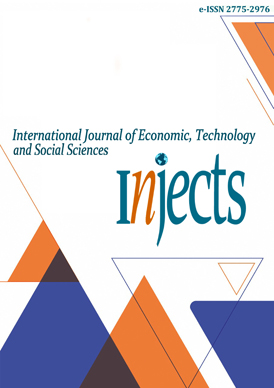FRAUD DETECTION ANALYSIS OF PRESENTATION OF FINANCIAL STATEMENTS OF PROPERTY AND REAL ESTATE COMPANIES ON THE INDONESIA STOCK EXCHANGE, 2018-2019
DOI:
https://doi.org/10.53695/injects.v2i2.455Keywords:
Fraudulent Financial Statement, Beneish M-Score, Fraud Triangle, Fraud DiamondAbstract
The aim of this research was to test the effects of fraud diamond on fraudulent financial statement. The samples of this research is property and real estate companies listed on Indonesia Stock Exchange (IDX) in 2017 to 2018 periods. The number of companies were 40 companies with 2 years observation. Based on purposive sampling method, sample total is 80. The data analysis methods used logistic regressions. Data were collected using a secondary data in the form of annual report that were downloaded from www.idx.co.id. The method of data analysis used in this study was logistic regression using SPSS 26.0 . The results of these research indicate thatfinancial stability, external pressure, financial target, nature of industry ratio, audit opinion and director change has no significant impact on fraudulent financial statement (Beneish M-Score) with 0.649, 0.142, 0.658, 0.750, 0.999 and 0.545 significant value.References
Abdullahi, Rabi’u dan Mansor, Noorhayati. (2015). Fraud triangle and fraud diamond theory: understanding the convergent and divergent for future research. International Journal of Academic Research in Accounting, Finance and Management Sciences. Vol. 5, No. 4, 38-45.
AICPA, SAS No.99. 2002. Consideration of Fraud in a Financial Statement Audit, AICPA. New York
Aprilia, 2017. “Analisis Pengaruh Fraud Pentagon Terhadap Kecurangan Laporan Keuangan Menggunakan Beneish Model Pada Perusahaan Yang Menerapkan Asean Corporate Governance Scorecard”.Jurnal Aset ( Akuntansi Riset ) . 9 (1), 2017, 101 – 132.
Aprilia, 2017. “Pengaruh Fraud Pentagon Terhadap Deteksi Fraudulent Financial Reporting Dengan Menggunakan Metode Beneish M-Score Model”.e-Proceeding of management : Vol. 6, No 2 Agustus 2019.
Association of Certified Fraud Examinations (ACFE). 2014. Reports to the nations: On occuppational fraud and abuse. Global Fraud Study.
Association of Certified Fraud Examiner. (2016) Report to The Nations on Occupational Fraud and Abuse. (Retrieved from:https://www.acfe.com/rttn2016/docs/2016-report-to-thenations.pdf)
Association of Certified Fraud Examiners. (2016). Survai Fraud Indonesia. Association of Certified Fraud Examiners, 1–62.
Beneish, M.D. (1999) “The detection of earnings manipulation”. Financial Analysts Journal 24 – 36.
Cressey, D.R (1953) Other people’s money, dalam: “Detecting and Predicting Financial Statement Fraud: The Effectiveness of The Fraud Triangle and SAS No. 99”, Skousen et al. 2009. Journal of Corporate Governance and Firm Performance, 13: 53-81
Detik Finance (2009, September 9) “Usai manipulasi keuangan”. Waskita Karya segera direstrukturisasi. Detik Finance. (Retrieved from: https://finance.detik.com/beritaekonomi-bisnis/1200038/usai-manipulasi-keuangan-waskita-karya-segera-direstukturisasi).
Fakultas Ekonomi Unimed. 2017. Pedoman Penulisan Skripsi Mahasiswa Program S1. Medan
Ghozali, I. 2011. Aplikasi Analisis Multivariate dengan Program SPSS. Semarang: Badan Penerbit Universitas Diponegoro
Ghozali, Imam. 2016. Aplikasi Analisis Multivariate dengan Program IBM SPSS 23. Badan Penerbit Universitas Diponegoro.
Hugo, Jason (2019). Efektivitas Model Beneish M-Score Dan Model F-Score Dalam Mendeteksi Kecurangan Laporan Keuangan. Jurnal Muara Ilmu Ekonomi dan Bisnis. Vol. 3, No. 1, April 2019 : hlm 165-175
Harahap, Sofyan Syafri. 2008. Analisis Kritis atas laporan Keuangan. Jakarta : Raja Grafindo Persada.
Inayanti, Shofia Nur 2016. “The Effect Of Factors In Fraud Diamond Perspective On Fraudulent Financial Reporting”.Accounting Analysis Journal : AJJ 5 (3) (2016)
Institut Akuntan Publik Indonesia. 2017. Standar Profesional Akuntan Publik, Per 1 Maret 2017, Penerbit Salemba Empat. Jakarta.
Jensen, M. C. dan Meckling, W. H. (1976) “Theory of the firm: Managerial behavior, agency costs and ownership structure”. Journal of Financial Economics 3(4): 305-360. doi:10.1016/0304-405X(76)90026-X.
Kasmir. (2018). Analisis Laporan Keuangan. Depok: Rajawali Pers.
Sanusi, Anwar. 2016. Metodologi Penelitian Bisnis. Jakarta: Salemba Empat
Kieso, Donald E, Jerry J. Weygandt, Terry D. Warfield. 2017. Akuntansi Intermediate. Terjemahan, Jilid 1. Jakarta: Salemba Empat
Oktaviana,Nimas Fransiska et al. 2019. “Analisis Fraud Keuangan Dengan Wolfe Dan Hermanson Fraud Diamond Model Pada Perusahaan LQ45 Di Busra Efek Indonesia )”. The 5th Seminar Nasional dan Call for paper - 2019.
Santoso, Singgih. 2015. Menguasai Statistik Parametrik Konsep dan Aplikasi dengan SPSS. Jakarta: PT Elex Media Komputindo
Sanusi, Anwar. 2016. Metodologi Penelitian Bisnis. Jakarta: Salemba Empat
Sihombing, Kennedy S. dan Rahardjo, Shiddiq Nur. (2014). Analisis fraud diamond dalam mendeteksi financial statement fraud: studi empiris pada perusahaan manufaktur yang terdaftar di bursa efek indonesia (BEI) tahun 2010-2012. Diponegoro Journal of Accounting. Vol. 03, No. 2, 1-12.
Sugiyono. (2015). Metode Penelitian Bisnis (Pendekatan Kuantitatif, Kualitatif, dan R&D). Bandung: Alfabeta.
Sunardi dan M Nuryatno 2018. Fraud detection of financial statement by using fraud diamond perspective. International Journal of Development and Sustainability. Vol. 7 No 3 Pades 878 – 891
Skousen, C. J., Smith, K. R., & Wright, J. C. 2009.Detecting and Predicting Financial Statement Fraud: The Effectiveness of the Fraud Triangle and SAS No. 99. Corporate and Firm Performance Advances in Financial Economics. Vol. 13 : 53 - 81.
Wolfe, D. dan Hermanson, D. (2004) “The fraud diamond: considering the four elements of fraud”. The CPA Journal 74 (2): 38-42.
http://www.idx.co.id/




